ADP, released their proprietary private payrolls jobs report. This month ADP is reporting a gain of 176,000 private sector jobs in June. May 2012 was revised up by 3,000, from 133,000 to 136,000. In contrast, the BLS reported 82,000 private sector jobs for May 2012. Graphed below are the reported private sector jobs from ADP. This report does not include government, or public jobs. ADP rarely mirrors the BLS report, which is released tomorrow.
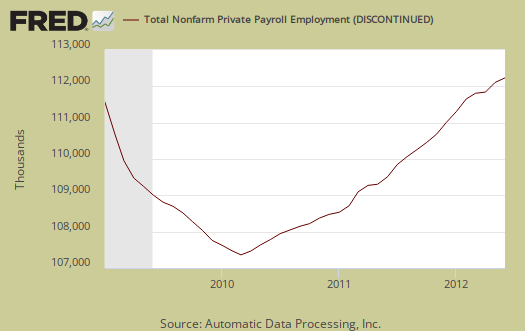
Almost all of ADP's private job growth was in the service sector, the 2nd month in a row, which gained 160,000 jobs. The goods sector only gained 16,000 jobs. Manufacturing, part of the goods sector, gain 4,000 jobs, a reverse from May's 2,000 decline. Construction added 8,000 jobs, also a reverse of the last two months. ADP's financial services jobs increased by 11,000 jobs, the 11th month in a row for private payroll increases for the financial sector.
This report, if it matches Friday's official unemployment report, would overall imply overall moderate job growth. Governments have just been shedding jobs, which are part of the BLS report. The U.S. needs about 100,000 jobs per month just to keep up with population growth.
ADP captures jobs by business size, which is one of the best features of this report, due to it's relativity using the same statistical methods and timeline. In June:
Employment on large payrolls—-those with 500 or more workers-—increased 11,000 and employment on medium payrolls—-those with 50 to 499 workers—-rose 72,000 in June. Employment on small payrolls—-those with up to 49 workers-—rose 93,000 that same period. Of the 72,000 jobs created by medium-sized payrolls, 7,000 jobs were created by the goods-producing sector and 65,000 jobs were created by the service-providing sector.
Below is the graph of ADP private sector job creation breakdown of large businesses (bright red), median business (blue) and small business (maroon). For large business jobs, the scale is on the right of the graph. Medium and Small businesses' scale is on the left.
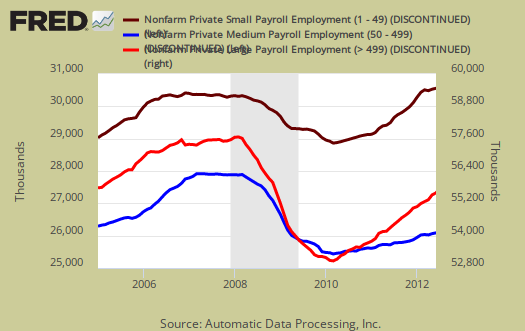
Large business, who lobby Congress for their bad trade deals, more offshore outsourcing through foreign guest worker importation and labor arbitrage, are almost absent from job creation in terms of hiring Americans. Notice how large businesses cliff dove in 2008, shedding employees, and have not returned at all to pre-recession employment levels. This pattern actually starts just about the time offshore outsourcing and the China PNTR came into effect, year 2000. Small businesses, on the other hand, have increased employment. May I suggest that small businesses are not international, they are not signing offshore outsourcing contracts and moving jobs to India and China. Multinationals, on the other hand, the below decade trend line clearly shows these so called U.S. corporations have abandoned the U.S. worker, on whole.
There is a historic strong mismatch between ADP and the BLS jobs report, although recently the two are converging again recently. To date, the number of private nonfarm payroll jobs ADP reports versus what the BLS reports and on a month-to-month and even cumulative basis do not match. This monthly error is often large, especially when looking at small job growth overall (< 400,000 jobs per month) on a month to month basis. The monthly BLS jobs survey (CES) has a 100,000 payroll jobs overall margin of error.
The below graph shows shows how many private sector payroll jobs, each month, ADP was off by in comparison to what the BLS reported. This is a monthly graph, not cumulative. As we can see, it's rare where the two monthly reports get the exact same private payrolls growth numbers and April was off by 17,000 jobs, May was off by 54,000. When the below graph number is negative, that means the BLS reported a larger number of jobs than ADP did, when the graph bar is positive, it means ADP reported larger private payrolls. Again, these are private sector jobs which is different from the BLS headline number. This graph was updated with the June BLS jobs report.
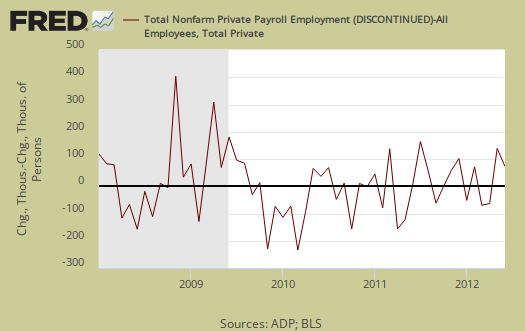
Below is the cumulative difference between what the ADP reports as the private nonfarm payroll jobs vs. the BLS (ADP minus BLS). This line shows the divergence, over time in number of nonfarm private payroll jobs reported between the two reports. The difference was stabilizing around 400,000, now increasing once again. This article was updated with the June BLS private non-farm payrolls data.
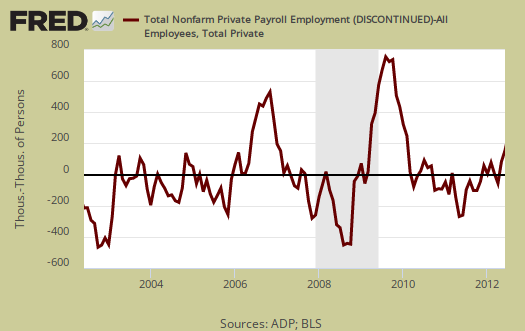
While ADP notes a simple correlation of 0.95, well, a 5% error between monthly reported jobs numbers is an average, and we can see on some months the differences are quite large and around 2008, the difference started to hit about 900,000 jobs. That said, the reported job growth is so piss pour, statistically we're rolling around in the margin of error each month.
ADP does use the same seasonal adjustment as the BLS, but their other methodology and even sampling size are different, proprietary. That said, ADP has now put up some details of their methodology to explain the statistical differences between their estimate, the actual mathematics, vs. the BLS. This is new, and good ADP is disclosing their entire methodology so we may get more apples to apples comparisons of the two reports. The graph below is the monthly change of private jobs as reported by ADP.
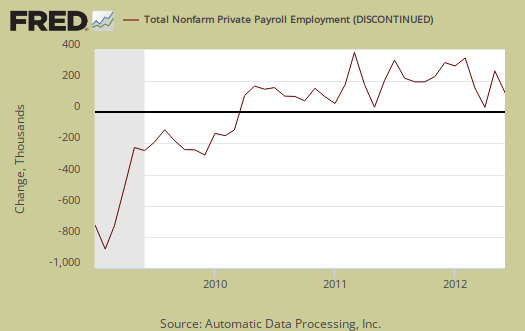
Regardless of the statistical differences between ADP and the BLS, June's report indicates a moderate job growth. Sorry folks, 100k range job growth numbers do not mean the Gods are now shining upon us. More we're all simply used to seeing beyond belief, pathetic job growth numbers. We still have estimated 28 million people needing a job. Four Hundred thousand monthly job growth, on the other hand, would be something to sing hallelujah over.
Here is last month's ADP private sector jobs report overview, only graphs revised.

Great data analysis
I always look forward to your analysis of the latest job numbers. Appreciate the graphs.
:)
Thx, BLS "should" be a little better than May
Between this and the ISM employment sub-indices, I expect to see a BLS report around or above 100k tomorrow. But you can bet I'll be graphing that puppy up til doomsday. I think I'll try to do some quarterlies, since the month-to-month on BLS data is really flaked out, esp. the CPS survey, high noise IMHO.
Glad you appreciate this, I find getting a feel for data without graphs or at least tables is nuts.
oops wrong o, about the same as May
77k for May, revised, 84k (private) for June.